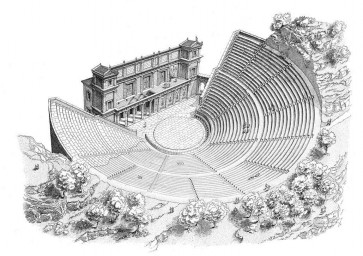
-
Which are the main characteristics of the three parts of the ancient theatre?
The orchestra is the oldest part of the theatre. Its name derives from the ancient Greek verb “orchoumai”, which means “to dance”, and it was created for the chorus’ movement. Its shape initially resembled to a circle or to a horseshoe, and later to a semicircle. In the Greek theatres its flooring was of beaten earth, while it was covered with slabs in the Roman ones. In its centre there was usually the thymele, the altar dedicated to Dionysus.
The cavea is the seating area for the public which develops amphitheatrically next to the orchestra. In the Greek theatres the cavea is on a hillside. At first, the spectators sat on the ground or on wooden benches. The plays of the tragedians were presented for the first time in such theatres. In the 4th century B.C., stone seats, the edolia, were constructed. The cavea is divided in two or three zones by horizontal corridors, the diazomata. The staircases help the circulation of the spectators and go up the cavea like rays, while they divide it in vertical sections, the kerkides. On the first row, important citizens like archons and priests sat on honourary seats, the proedries. Unlike the Greek theatres, the Roman ones were not built on hillsides, but on flat surfaces with a surrounding wall which retained their exterior side.
The skene (stage building) is an elongated roofed building at the back of the orchestra. Initially, it was a wooden structure and it served as a simple background, as a storage area of the performance’s equipment or as a space for the preparation of the actors, like the modern dressing rooms. Gradually, the skene became a permanent stone structure, and then a two-storied building. It acquired three doors and windows giving the impression of a façade. Later on, on its flat roof appeared the actors who were separated from the chorus.
-
What kinds of spectacles did it host?
Depending on the period, the theatre is associated with different functions. Firstly, it hosted theatrical performances, and other events such as political gatherings, philosophical lectures etc. On the contrary, the theatrical performances are scarce in the Roman theatres, which notably host mimes, pantomimes and other popular spectacles to the Romans like gladiators and wild animals fights.









